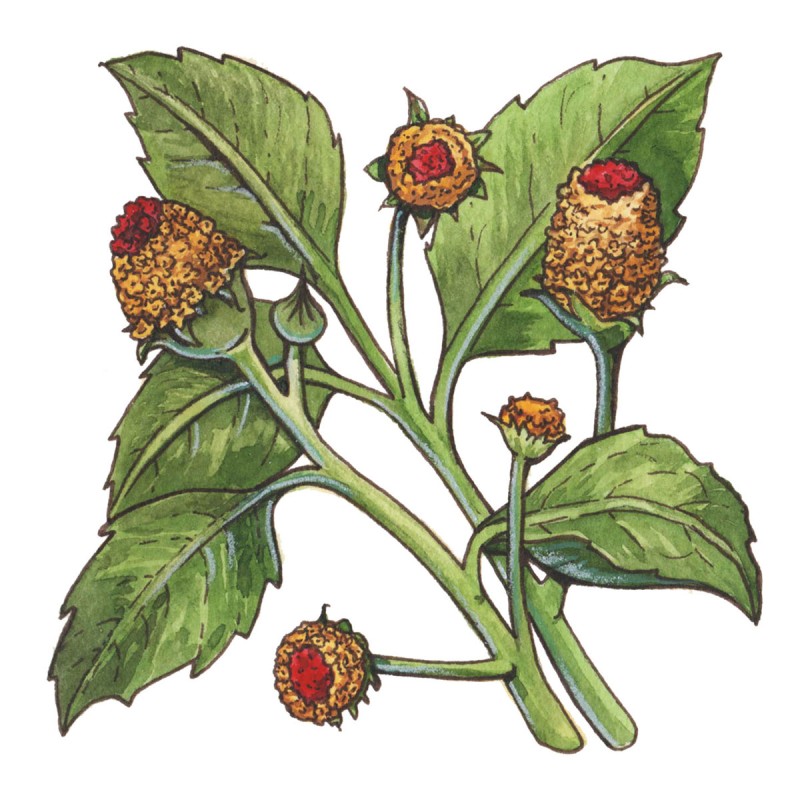
Common Names
- Jambu
- Toothache plant
- Electric daisy
- Paracress
- Buzz buttons
- Schezuan buttons
For Patients & Caregivers
Tell your healthcare providers about any dietary supplements you’re taking, such as herbs, vitamins, minerals, and natural or home remedies. This will help them manage your care and keep you safe.
Spilanthes, also known as the “toothache plant”, may have numbing and pain-relieving effects, but human data are lacking.
Spilanthes is an herbaceous plant that belongs to the daisy family. It is recognized in traditional medicine throughout Asia and South America for a variety of properties including anti-inflammatory, diuretic, and aphrodisiac effects. The leaves are used as food sources. The flowers of Spilanthes have earned it the name “toothache plant” for their numbing and pain-relieving effects.
Spilanthes has also been noted to stimulate taste and improve saliva flow. Therefore, whether it could help side effects from cancer treatments such as dry mouth, mouth sores and inflammation, or changes in taste sensation may be of interest to researchers. However, very few studies have been conducted and none of them have yet been done in humans.
Toothache or gum infections
Lab studies suggest Spilanthes may protect against certain bacterial and dental infections, but there are no human data.
Sore throat or sore mouth
Lab studies suggest Spilanthes may have a numbing effect and reduce inflammation, but studies have not yet been conducted in humans.
Inflammation and wound healing
Animal studies suggest that compounds in Spilanthes may protect against or heal ulcers.
In general, human data are lacking.
Case report
Painful lip swelling: In a 42-year-old man who went to the emergency department. The suspected cause was an appetizer of “Szechuan buttons” ingested several days earlier, in the absence of any other explanation.
Do Not Take if:
- You are using diuretics (water pills) for blood pressure or swelling: Animal studies show Spilanthes can promote urination and may increase the risk of adverse effects.
- You have prostate cancer: Animal studies show that Spilanthes stimulates male hormone production, especially at high doses. This may affect the actions of drugs used to treat prostate cancer.
- You are pregnant: Animal studies suggest the potential for birth defects with high doses of this botanical.
Special Point:
Spilanthes, an herbaceous plant that grows in tropical and subtropical regions, should not be confused with jambu madu or wax jambu, which are names for the wax apple fruit tree that is widely cultivated in Southeast Asia.
For Healthcare Professionals
Spilanthes acmella is an herbaceous plant that belongs to the family Asteraceae. It is used in traditional medicine throughout Asia and South America, where it is known as Jambu. The leaves are used for culinary purposes, and the flowers have been used for their numbing and pain-relieving properties, earning the plant such common names as the toothache plant. In addition, it has been noted to relieve stomatitis, have taste-activating properties, and to induce a salivary response.
In vitro and animal studies suggest that Spilanthes, related species, and their compounds have antimicrobial (2) (3) (10), antinociceptive (8) (9) (11), anti-inflammatory (6), gastroprotective (12) (13), and taste-activating (4) properties. Spilanthol and acmellonate, compounds derived from this plant, are associated with reduced toothache pain and increased saliva secretion (1). Other experimental studies suggest diuretic (7) (18) and aphrodisiac (5) (19) effects.
In vitro, a hydroethanolic extract of S. acmella produced cytotoxic effects in tumor cell cytoskeletons (16). In murine models of 5-fluorouracil-induced intestinal mucositis, spilanthol from A. oleracea reduced inflammation (20). However, human data are lacking.
- Gum infections
- Inflammation
- Sore throat
- Stomatitis
- Toothache
- Wound healing
Antinociceptive effects have been attributed to anti-inflammatory properties (11) and engagement of opioid receptors (9). Compounds that induce tingling sensations associated with topical application or chewing of jambu include spilanthol, and to a lesser degree acmellonate (4). Taste-activating alkamide compounds that induce a salivary response have also been identified (4). Spilanthol is among the most active alkamides isolated from aerial parts of A. oleracea to demonstrate insecticidal (14) and acaricidal (15) activity.
In animal models, spilanthol isolated from S. acmella reduced inflammatory responses via NFk-B inactivation (6). Potential mechanisms for gastroprotective effects with rhamnogalacturonan, a polysaccharide isolated from A. oleracea, include protectively binding to the mucosal surface, increasing mucus synthesis, scavenging radicals, and diminishing secretions of acid and pepsin (12). Other research suggests rhamnogalacturonan promotes restoration of epithelial continuity via epithelial cell proliferation and enhances mucin production to promote gastric ulcer healing (13).
In vivo, potential teratogenic activity in embryos may be due to various spilanthol metabolites (21). An animal study found that an S. acmella ethanolic flower extract rich in alkylamides affected male sexual functioning by increasing levels of testosterone, follicle-stimulating hormone, and luteinizing hormone (5), with the effect being significant and lasting at high doses.
Patients with androgen-sensitive prostate cancer: In an animal study, an alkylamide-rich S. acmella ethanolic flower extract increased levels of testosterone, follicle-stimulating hormone, and luteinizing hormone (5).
Pregnant women: In vivo studies suggest potential teratogenic effects with high doses of a hydroethanolic extract of A. oleracea (21).
In general, human data are lacking.
Case Report
Painful lip swelling: In a 42-year-old man who presented to the emergency department. The suspected cause was an appetizer of “Szechuan buttons” ingested several days earlier, in the absence of any other explanation (22).
- CYP 2E1 substrates: In vitro studies suggest spilanthol significantly inhibits CYP2E1 (17). Clinical relevance has yet to be determined, although drugs in this class include those used in general anesthesia such as isoflurane and sevoflurane.
- Antiandrogen drugs (bicalutamide, flutamide, abiraterone): In animal studies, S. acmella may increase testosterone levels (5). Clinical relevance has yet to be determined.
- Diuretics: In animal studies, S. acmella has loop diuretic activity (7), and may have additive effects with other diuretic drugs.